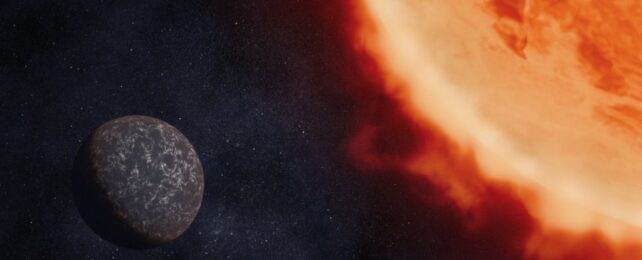A nearby alien world is finally confirmed to have one side locked in permanent darkness and the other in endless sunshine.
It's the first compelling evidence that planets outside our Solar System can become 'tidally locked' to their host stars, with an orbital period exactly the same as its rotational one. The result of this is that one side of the exoplanet always faces the star, with no respite from the scorching heat; and the other side experiences perpetual night.
Luckily, the world, known as LHS 3844b, or Kua'kua, is so close to its host star Batsũ̀ that it is rendered uninhabitable to life as we know it. But the finding finally confirms something astronomers had long suspected – that tidally locked exoplanets are possible and maybe even common in the Milky Way.
"This thing that has been theoretical now feels real," astronomer Nicolas Cowan of McGill University in Canada told Nature. "This is actually what these planets look like."
Tidal locking is a phenomenon that we can observe right here in the Solar System, although not in any of the planets around the Sun. Ever notice that you only ever see one side of the Moon? That's because it's tidally locked to Earth. It happens when the gravitational interaction between two bodies causes their rotations to slowly synchronize with their orbit.

As the two bodies orbit, the gravitational force between them exerts a pull that causes each to distort and bulge towards another slightly. The distorted shapes affect their rotations in such a way that each object synchronizes with its orbit. Being smaller, our Moon's rotation has already fallen into sync with its monthly lap around our planet, though Earth's rotation is also slowing by milliseconds every century thanks to its satellite's firm tug.
Exoplanets that are close to their stars are thought to be the most likely to be affected, since they're subjected to a stronger gravitational pull. But exoplanets are pretty hard to observe directly. We can discern some of their properties indirectly, such as their size, mass, and density, but we've never actually seen most of them directly; and those that we have, we can't see in detail.
One property we can calculate using light intensity data, however, is temperature, and this is what gave the researchers their entry into determining the rotation of Kua'kua, which has an orbital period of just 11.1 hours.
Previous research has revealed that the exoplanet – orbiting its star 48 light-years away – is 1.3 times the radius and 2.25 times the mass of Earth. This is consistent with a density of 5.646 grams per centimeter cubed – just a little higher than the density of Earth, suggesting a rocky composition. Research also suggests that Kua'kua doesn't have an atmosphere, meaning that any temperature readings are directly related to its surface.
Led by astronomer Xintong Lyu of Peking University in China, the researchers developed a global thermal model of an exoplanet without an atmosphere, and compared it to observations of the system taken using the infrared Spitzer telescope.
Specifically, they were looking for evidence of the internal heating that is generated by the ever-changing distortion during an asynchronous orbit. If the exoplanet was not tidally locked, the internal stress generated by the gravity of the star constantly trying to change its shape would heat Kua'kua up inside, and this would be detectable in infrared light.
Instead, what they found is that the exoplanet is far too cool for anything other than a tidally locked orbit. It's possible that the world does have a thin atmosphere, but if it doesn't, it's essentially a naked, tidally locked rock – pretty much like the Moon, but bigger.
We'll need further observations with more powerful instruments to confirm; but, currently, the results represent the best evidence yet that some worlds can be locked to their stars.
The team's research has been published in The Astrophysical Journal.
